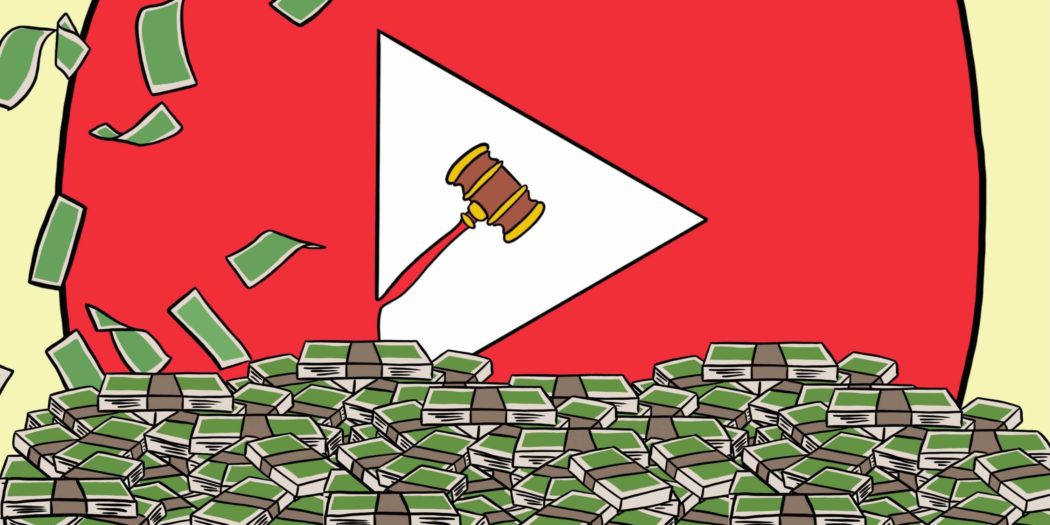YouTube’s troubling copyright system
You know about YouTube and the monster of a corporation it has become since its start in 2005. Creators such as Fred and The Annoying Orange were among the first to reach a million subscribers (Cruikshank, DaneBoe) and go viral worldwide. With the help of “Charlie Bit Me” and the popular music video “Shoes,” YouTube became a place for individual creators to post videos and gain a following.
Unfortunately, YouTube is not the same place it was 15 years ago. It is convoluted with over 400 hours of video being uploaded to the site a minute. About 75% of creators have over a million subscribers, with the number one individual creator, PewDiePie, rounding out with an astounding 109 million subscribers. A rise in popularity has led to a number of issues, many of which creators have spoken out about. The company has attracted the attention of tabloids and media as well as massive corporations looking to make a quick buck. Freedom of speech and the concept of fair use are constantly debated on the platform as the number of content ID and copyright claims rise. With the potential to do so much good, why has YouTube done so much harm?
Under the United States Copyright Doctrine, fair use is lawful, unlicensed use of copyrighted materials in transformative ways such as commentary, parodies, teaching, research, reviews and so on. When viewing works in a court of law, judges look at the purpose of using copyrighted material, how much is used and the effect the use will have on viewers. However, there is a major problem limiting the lack of free speech on YouTube: the ability for companies and corporations to file false content IDs on individual creator’s videos.
Creator Gus Johnson, whose channel racks up over three million subscribers, made a video in 2018 when a video of his was falsely copyright claimed. He exclaimed in frustration, “I made a video about it [“Bohemian Rhapsody” by Queen] where I talk about the issue, I talk about the issue, I don’t play even a f**king microsecond of the song and boom. What do I wake up to today? A manual claim, not even automated detection, went in and manually claimed this video as containing stuff from EMI Music Publishing.”
Johnson then went on to explain that even putting the names of music artists or their songs in the titles of videos would result in a copyright strike.
I reached out to some of these creators for their input and received even more troubling news. Take BionicPig for example, who currently has over 600,000 subscribers.
“It doesn’t matter who they plow over, whose channel they delete, whose money they take, as long as they take the money,” he said when asked how YouTube could repair their broken content ID system. “They need a third-party option if I get copyright claimed.”
BionicPig said he got ten in the past month, joining the ranks of hundreds of other creators facing the same problem.
“I get to do something called a dispute,” he said. “What happens is it gets sent back to the person who gave you the copyright claim. You can dispute it, but they can say it’s ours because, well, it is. There’s nothing you can do about it.”
Creator BestAtNothing, whose channel has over half a million subscribers, expressed his frustrations with the system and the disproportionate number of false claims companies issue.
“The problem is that the final decision usually rests in the company making the claim. Even if you provide valid proof their claim is false, they can deny it and you are virtually powerless to challenge it,” he said. “It’s an easy cash grab. I’m not sure how it can be fixed unless fair use becomes more clearly defined by law, or if YouTube decides to review copyright claims themselves.”
“There’s no third party to say, ‘no, you’re wrong, this is fair use and this is their video,’” BionicPig continued. “That’s the big issue here on YouTube. Companies can just do what they want. When it comes down to fair use, there is no concrete way to define it. That’s why it’s so simple and so easy for corporations to say it’s theirs.”
Johnson further explained during the dispute process companies will receive all the revenue a video makes until the dispute is either approved or denied. More often than not, it gets denied, and that creator loses out on the income that content would have provided them.
“I think this it is incredibly important that we bring this to people’s attention,” Johnson said. “These are their paychecks, these are their monthly earnings that are getting f**ked with completely unreasonably. I’m just a kid in my room; half this site is just kids in their rooms.”
An academic journal written by Dustin Edwards explained that YouTube’s Content ID system acted as a circulation gatekeeper: people, institutions, technologies, etc. control how content moves. For example, this copyright database decides who will profit from the spread of the video. This leads to an “authorship hierarchy” where corporations have the “upper hand in monetizing and/or suppressing” the spread of content and hurting individual creators to “compose transformative work to claim Fair Use.”
Without a stricter definition or a group of people to defend it, freedom of speech is ripped away from YouTube creators who don’t have the money or time to sit and argue with corporations that have the upper hand.
BionicPig explained that YouTube never reaches out to try and settle problems with creators.
“There’s no connection, no ‘this is going on, we need to fix it.’ There have been thousands upon thousands of videos made by creators calling out YouTube saying ‘you need to do something about this,’ and they just don’t even say a word.”
BestAtNothing made it clear he didn’t feel valued as a content creator and some days didn’t want to continue uploading videos.
“What they [YouTube] value is how much money you make them and how good an image of YouTube you create. If you create very family-friendly, broadly appealing content, YouTube will “value” you more in that you’re a valuable money maker that makes them look good. They don’t really care about any individual creator big or small, just what they can do for the company.”
“There is no longer incentive for someone starting out now,” BionicPig said.
*Graphic by Regan Johnson.
 Sydney Dahle is a fourth-year student studying history and political science at Utah State and is currently the Lifestyles Content manager for the Utah Statesman. She hails from St. Louis, Missouri, and spends her free time writing and listening to music.
Sydney Dahle is a fourth-year student studying history and political science at Utah State and is currently the Lifestyles Content manager for the Utah Statesman. She hails from St. Louis, Missouri, and spends her free time writing and listening to music.
—sydney.dahle@usu.edu
@dillydahle

